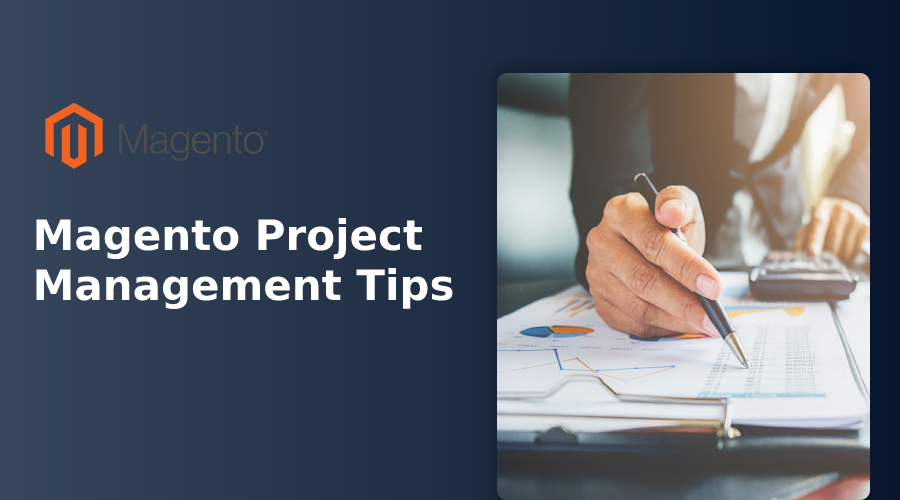
Magento project management, or project management in general, is vital to any business. For many people, it is just about how you plan, budget, and execute. In fact, the thing can get as complicated as you can think of. The right way to go can vary from one business to another.
If you are here because there is an upcoming Magento Project to manage, below are some tips we have consolidated to help you get a grasp of this as quickly as possible.
Table of Contents
I. Top 10 Technical Tips For Every Magento 2 Project
Magento 2 brands itself as the world’s most flexible eCommerce platform. While there will always be debates about the greatest in any industry it’s safe to say it’s one of the leading eCommerce platforms out there today. The abundance of out-of-the-box features makes it an easy choice for small, medium, and large merchants.
With original Magento 2.0 releases having some teething problems, Magento really took off with the release of PHP 7 and Magento 2 bills itself as the most adaptable eCommerce platform on the market. While there will always be discussions about who is the best in any business, it is reasonable to state that it is one of the most popular eCommerce platforms today. It is an obvious choice for small, medium, and large merchants because to the abundance of out-of-the-box functionality.
After some teething issues with the early Magento 2.0 versions, Magento took off with the release of PHP 7 and improvements that dramatically improved performance in future releases. These enhancements resulted in significant speed gains, making Magento 2 all the more tempting to merchants looking to take their eCommerce to the next level.
Implementing a Magento site, on the other hand, can be a difficult and intimidating undertaking that necessitates a diverse skill set. Not only does the Magento technological stack include LAMP (Linux, Apache, MySQL, and PHP), but also Memcached, Redis, Elasticsearch, Solr, Varnish, and a split database solution, to mention a few.

We intended to take a high-level approach and highlight some of the most basic technical aspects that every Magento implementation should cover:
1.1. Understanding Composer
Despite the fact that we can install Magento by simply downloading an archive file, Composer is another way to access Magento source files. We can even use the “composer create-project…” function to install Magento. While we don’t need to be specialists in Composer, we do need a fundamental understanding to better understand how Magento works with it.
1.2. Using Git
Git is the most popular version control system nowadays. Without a doubt, every Magento project should use Git (or another version control system) to track source file changes.
1.3. Master The Magento Console Tool
Master the Magento console tool – the Magento console tool provides a plethora of choices for managing Magento installations via the command line. Cache, indexers, deployment mode, modules, backups, and more may all be managed here.
1.4. Understand The Application Cache
Recognize the application cache. – Magento comes with a number of cache types (config, layout, block HTML, collections, reflection, DB DDL, eav, customer notification, target rule, full-page, config integration, config integration API, translate, config web service) out of the box. Understanding everyone’s function is essential for development and eventually production troubleshooting.
1.5. Understanding The Indexers
Magento includes several cache types out of the box (design_config_grid, customer_grid, catalog_category_product, catalog_product_category, catalog_product_price, catalog_product_attribute, cataloginventory_stock, catalogsearch_fulltext, catalogrule_rule, catalogrule_product, targetrule_product_rule, targetrule_rule_product, salesrule_rule). For production store operations, it is critical to understand each individual’s job.
1.6. Cron Jobs
Magento makes extensive use of cron features. Emails, catalog price rules, reindexing, and other features won’t operate unless cron jobs are set up. We need to deal with three different sorts of cron jobs: php update/cron.php, php bin/magento setup:cron:run, php bin/magento cron:run
1.7. Utilizing The Varnish / HTTP Cache
Using Varnish adds an extra caching layer in front of our web server, although PHP 7 alone with built-in full-page caching provides significant performance gains. Varnish can minimize response time and network bandwidth by sitting in front of the webserver and proxying these requests to the web server. Understanding how to configure Magento with Varnish is essential for even better performance.
1.8. Utilizing The Redis
Redis is a key-value data store that runs in memory and is perfect for application caching and session storage. Magento uses Redis for its page and default caches, as well as session storage, out of the box. Another important aspect of improving performance is learning how to configure Magento with Redis.
1.9. Utilizing The Elasticsearch / Solr
It doesn’t matter if your store is lightning fast if your clients can’t find what they’re looking for. Elasticsearch and Solr are both supported by Magento EE. Knowing how to set up and use one of these features can mean the difference between a conversion and a lost consumer.
1.10. Magento Itself
Developing for Magento successfully necessitates a thorough understanding of PHP, JavaScript, XML, MySQL, and HTTP in general. Having a thorough understanding of the modular Magento architecture and its overall technology stack makes all the difference for production running stores, whether you’re a developer or more of a system operations role. It is critical that you have enough project management experience on your team to cover these bases and ensure a successful project.
The list above provides an overview of the prerequisites for learning some of the most important technical aspects of a Magento 2 project. We understand that every project is unique, and you may have additional technical concerns that need to be addressed.
II. Planning
2.1. Blueprint
A blueprint is an overall picture of your Magento journey, and it should be treated with utmost care.
You need to identify the structure of the project with stages and key points, objectives, and how to execute them. Take Customer Journey as an example, there are stages that the customers will go through when they go shopping on your site, such as Sales, Delivery, Customer Care, etc.
After the outline is finished, running through your blueprint from start to end can enable you to have a clear look at where the problems might occur and prepare solutions for them in advance.
2.2. Clear Objectives
One of the most important tips for successfully managing a project is to have clear and measurable objectives since you will know where is your project heading with the goals always be in sight. There are some suggested questions to ask your client when establishing goals:
- What are the criteria for a successful project?
- What are the goals in terms of business?
- Are the objectives measurable?
- What methodology will be used to approach the plan?
- What are the milestones in your plan?
With clear goals, all team members can have the same idea about where to go with their execution and what to achieve. The above questions will also serve as a guide for possible improvements if the plan did not turn out as expected.
2.3. Financial and Time Budget
Basically, any project comes down to how much time and money you have. If your fund is large, the time required can be reduced significantly, and vice versa. Therefore, it is essential that you come up with detailed estimated costs and actionable deadlines for your plan. To be able to create a realistic plan, take all of your objectives and executions into consideration.
2.4. Responsibility
Task delegation also needs to be taken care of. Well-planned task delegation can guarantee the least amount of error and more effective communication.
Besides matching the right person and the right task, project managers also need to focus on the desired results, not every small task. Also, determine an order in which more important tasks will be prioritized.
III. Communication with Client

Your client needs to be with the Magento project management process all along to ensure it is going the way they want, and you are managing with their view in mind. Communication with your client, therefore, needs to be open and effective.
3.1. Ask Your Questions
Asking help clarify everything you and your team need to know about the Magento project. Be detailed as much as you can, even if some questions are simple because many times a project failure stems from a thing that is not stated clearly, only implied or inferred.
3.2. Your Magento Project Management Plan and Review
Presenting your plan to your client and reviewing it can bring out a lot of details both sides might not think about yet. This is also where expectations are managed before anything starts. With written materials, these conversations can be a type of guideline for later work.
3.3. Communication Methods
Various methods of communicating can lead to confusion or unnoticed, especially small, details. Letting everyone agree on how to communicate provide a baseline to stick to once the project run. For instance, you and your client might come to an agreement that there will be weekly reports via emails and monthly reviews through offline meetings.
3.4. Keep It Frequent
The more conversations you and your client have, the better the mutual understanding about the Magento project management would be. As your project goes, many problems might appear, keeping everyone in check regularly can help address the issues when they just arise.
3.5. Ask For Feedback
Feedback is possibly the best thing you can have to improve for next time. Don’t hesitate to ask for them as that is how you and your team can spot the weaknesses, enhance the skills, and step up your game.
IV. Development Team

The other crucial party in a Magento project management process is the development team. Besides taking care of technical issues and developing things, they also have the knowledge about the Magento platform that can benefit the project significantly.
Below are a few points on how you should work with your team to improve the end results as well as the overall performance:
4.1. Be Open-minded
As a project manager, in the end, your decisions matter the most. Nevertheless, a good decision-making process involves everyone in your team. Even if their proposed ideas go in different directions than your own, carefully take them into your account and be open-minded enough to change when necessary. After all, they are the ones who know best about how Magento works in terms of technicality.
4.2. Empower Your Team
After delegating tasks to your team members, make sure you give them enough space to make decisions where they can. One of the suggestions is to communicate about the minor goals and let the team decide on how to deliver that effectively. When being empowered, your team is motivated to go the extra steps for the best result.
4.3. Communication Amongst Team Members
Each member has a different job to do in a project. As important as it is to the client, communication with the development team should also flow smoothly. Standardize the methods and timeline for catching up so that everyone is aware of what happened as a whole project goes, not just their tasks.
V. Flexibility
Always flexible. Because no matter how well you have prepared or how good your team is, there are always unexpected factors and situations. Keep that in mind that you need to leave a place for changes and adjustments where needed. Do not keep things too tight and fixed.
VI. Cycle Of A Magento Project
There are several stages in a Magento project to identify how far it has gone. Let’s have a look at some common stages below:
- Estimating: At this stage, the cost and time requirements are being calculated by your team.
- In the queue: This stage happens after the quote provided by your team was approved by the client.
- Task allocating: During this stage, your team members can see which task is for who. At the end of it, all the tasks are delegated and everyone agreed on the schedule.
- Waiting for further clarification: used when there are new enquiries that need clarifications from the client.
- Testing: After every developing task is finished, the status is changed into this, meaning that the team is testing their work in different places.
- Deploying: The tested work starts running as planned and the team is waiting for the client’s feedback at this stage.
- Finished: Only after the client confirmed that there is no change needed that you and your team can change the status into “Finished”.
Our big thanks go out to every vendor that has made this Magento Project Management Tips 2023! This is the most comprehensive list of the best Magento Project Management Tips 2023 on the Internet and it’s our honor to have you as part of this!
If you want to add or remove any item in this list, feel free to submit your extension at Submit form.
Stick around. We will come back with more informational reviews!
Thank you and stay safe!











![[SALE OFF] Discount 30% All Premium Extensions On Christmas And New Year 2025 christmas-and-new-year-2025](https://landofcoder.b-cdn.net/wp-content/uploads/2024/12/christmas-and-new-year-2025-1-218x150.png)







